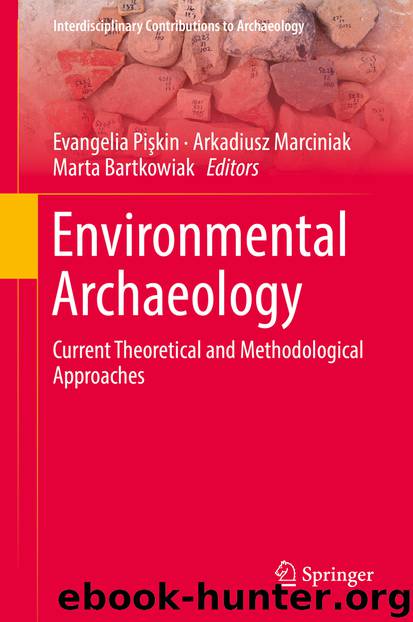Environmental Archaeology by Evangelia Pişkin Arkadiusz Marciniak & Marta Bartkowiak

Author:Evangelia Pişkin, Arkadiusz Marciniak & Marta Bartkowiak
Language: eng
Format: epub
Publisher: Springer International Publishing, Cham
3.3 Are Modern Populations Representative of Ancient Populations? The Cases of the Serial Founder Effect Model, Admixture and Population Replacement
Whether it be in human history or domestication research, studies often interpret mtDNA results based on demographic stasis illustrated through ‘serial founder effect’ models. In short, these models assume that following their initial expansion from a point of origin, populations remained in the geographical locations they first colonised, exchanging migrants with close neighbours at a very low rate. If indeed correct, then identifying the geographical origin of a particular domesticate would simply involve finding the geographical region with the highest genetic diversity (Pickrell and Reich 2014).
The model however implicitly assumes that populations today are direct representatives of past populations who used to live in that same locality. Crucial to the interpretation of the data is the fact that these models do not allow for admixture that we know occurred through population replacements and long-range migration. Genetic research on domesticates have already begun to show the dangers of using modern populations to infer the past (Flink et al. 2014), while Pickrell and Reich demonstrated that a declining heterozygosity in populations located further and further away from their presumed point of origin (as defined by the serial founder effect models) is consistent with multiple scenarios (Pickrell and Reich 2014). Furthermore, the domestication of certain plants is not as straightforward as a single domestication event. In the case of the banana, the origin of its cultivated form arose from multiple intra- and interspecific hybridisation events (Li et al. 2013).
Until recently, the majority of domestication studies were conducted on modern datasets. Indeed, limitations on the number of well-preserved archaeological samples impaired the size of high-resolution ancient DNA dataset, leading to modern data being the preferred choice. However, modern populations often little reflect the past and numerous events of migration, admixture and population replacement may have occurred. Perhaps the best case study to illustrate this point is that of dogs.
The domestication of the dog has puzzled archaeologists and geneticists for decades. While the archaeological record suggests a European domestication centre (Larson et al. 2012), mitochondrial DNA based on modern populations speculates a single domestication event within East Asia due to its larger genetic diversity (Pang et al. 2009; Savolainen et al. 2002). Other types of genetic data including a genome-wide SNP survey and Y-chromosome markers either support this theory (Brown et al. 2011) or refute it (Boyko et al. 2009; Sacks et al. 2013). Consequently, although it is generally agreed among both archaeologists and geneticists that there only was a single domestication event, no consensus on the geographic and temporal origins of dog domestication has yet been reached. By comparing modern mtDNA sequences and full genomes with modern SNP data, ancient European mtDNA sequences and the full genome sequencing of a late Neolithic dog (4800 years BP) excavated in Ireland, Frantz et al. showed dog domestication history and dispersal were more complex than originally thought. The study found that the divergence time between the East Asian
Download
This site does not store any files on its server. We only index and link to content provided by other sites. Please contact the content providers to delete copyright contents if any and email us, we'll remove relevant links or contents immediately.
| Africa | Americas |
| Arctic & Antarctica | Asia |
| Australia & Oceania | Europe |
| Middle East | Russia |
| United States | World |
| Ancient Civilizations | Military |
| Historical Study & Educational Resources |
Underground: A Human History of the Worlds Beneath Our Feet by Will Hunt(12022)
Sapiens by Yuval Noah Harari(5293)
Navigation and Map Reading by K Andrew(5111)
The Sympathizer by Viet Thanh Nguyen(4305)
Barron's AP Biology by Goldberg M.S. Deborah T(4096)
5 Steps to a 5 AP U.S. History, 2010-2011 Edition (5 Steps to a 5 on the Advanced Placement Examinations Series) by Armstrong Stephen(3687)
Three Women by Lisa Taddeo(3354)
Water by Ian Miller(3127)
The Comedians: Drunks, Thieves, Scoundrels, and the History of American Comedy by Nesteroff Kliph(3039)
Drugs Unlimited by Mike Power(2545)
A Short History of Drunkenness by Forsyth Mark(2233)
DarkMarket by Misha Glenny(2158)
The House of Government by Slezkine Yuri(2158)
And the Band Played On by Randy Shilts(2129)
The Library Book by Susan Orlean(2042)
Revived (Cat Patrick) by Cat Patrick(1963)
The Woman Who Smashed Codes by Jason Fagone(1929)
Birth by Tina Cassidy(1864)
The Absolutely True Diary of a Part-Time Indian by Sherman Alexie(1857)
